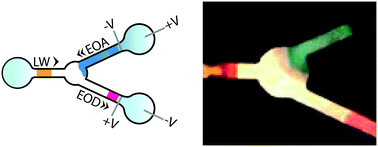Dynamic control of capillary flow in porous media by electroosmotic pumping†
Abstract
Microfluidic paper-based analytical devices (μPADs) rely on capillary flow to achieve filling, mixing and delivery of liquids. We investigate the use of electroosmotic (EO) pumping as a mechanism for dynamic control of capillary flow in paper-based devices. The applied voltage can accelerate or decelerate the baseline capillary-driven velocity, as well as be used to create a tunable valve that reversibly switches the flow on and off in an electrically controlled manner. The method relies on simple fabrication and allows repeated actuation, providing a high degree of flexibility for automation of liquid delivery. We adapt the Lucas–Washburn model to account for EO pumping and provide an experimentally validated analytical model for the distance penetrated by the liquid as a function of time and the applied voltage. We show that the EO-pump can reduce filling time by 6.5-fold for channels spanning several cm in length, relative to capillary filling alone. We demonstrate the utilization of the EO-pump for a tunable and dynamic flow control that accelerates, decelerates and stops the flow on demand. Finally, we present the use of the EO-pump for fluid flow sequencing on a paper-based device.



 Please wait while we load your content...
Please wait while we load your content...